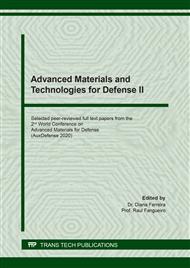[1]
G. Barrows, B. Krantz, Integrated RF sensors for electronic warfare applications, in IEEE International Symposium on Circuits and Systems. Emerging Technologies for the 21st Century, (2000).
DOI: 10.1109/iscas.2000.857395
Google Scholar
[2]
P. Bia, D. Gaetano, C. Canestri, A. Manna, D. Santoro, M. Pietrantuono, C. Mitrano, A Novel Integrated RESM-CESM Antenna for Naval Platforms, 2019 Photonics & Electromagnetics Research Symposium - Spring (PIERS-Spring), (2019).
DOI: 10.1109/piers-spring46901.2019.9017725
Google Scholar
[3]
D. Santoro, D. Bellisario, F. Quadrini, L. Santo, Anisogrid thermoplastic composite lattice structure by innovative out-of-autoclave process, Int. J. Adv. Manuf. Technol. 109(7-8) (2020) 1941-1952.
DOI: 10.1007/s00170-020-05671-6
Google Scholar
[4]
P. Goutham, P.B. Balareddy, T. Ekbote, Structural analysis of antenna reflector using composite materials, Mater. Today: Proceedings 4(10) (2017) 11126-11133.
DOI: 10.1016/j.matpr.2017.08.076
Google Scholar
[5]
G.Y. Lu, J.Y. Zhou, G.P. Cai, G.Q. Fang, F.J. Peng, Studies of thermal deformation and shape control of a space planar phased array antenna, Aerosp. Sci. Technol. 93 (2019) 105311.
DOI: 10.1016/j.ast.2019.105311
Google Scholar
[6]
B. Siriguleng, W. Zhang, T. Liu, Y.Z. Liu, Vibration modal experiments and modal interactions of a large space deployable antenna with carbon fiber material and ring-trudd structure, Eng. Struct. 207 (2020) 109932.
DOI: 10.1016/j.engstruct.2019.109932
Google Scholar
[7]
F. Xu, K. Zhang, Y. Qiu, Light-weight, high-gain three-dimensional textile structural composite antenna, Compos. B. Eng. 185 (2020) 107781.
DOI: 10.1016/j.compositesb.2020.107781
Google Scholar
[8]
D. Santoro, U. Lecci, F. Quadrini, L. Santo, Structural design of hybrid processing unit chassis for airborne electronic systems, Proceedings of the ASME 13th International manufacturing science and engineering conference, (2018).
DOI: 10.1115/msec2018-6422
Google Scholar
[9]
B. Ozdemir, E. Salamci, M. Kuloglu, A.M. Ates, Comparison of radome sandwich structures with finite element method, Mater. Today: Proceedings (2020).
Google Scholar
[10]
L. Zhang, Z. Yue, L. Li, Ceramic-polymer composites with low dielectric loss for microwave antennas and wireless sensors, Key Eng. Mater. 655 (2015) 153-158.
DOI: 10.4028/www.scientific.net/kem.655.153
Google Scholar
[11]
L. Zhang, Z. Yue, L. Li, Low dielectric loss polymer-ceramic composites for wireless temperature sensation, Key Eng. Mater. 602-603 (2014) 752-756.
DOI: 10.4028/www.scientific.net/kem.602-603.752
Google Scholar
[12]
S.B. Clay, P.M. Knoth. Experimental results of fatigue testing for calibration and validation of composite progressive damage analysis methods, J. Compos. Mater. 51 (2016) 2083-2100.
DOI: 10.1177/0021998316670132
Google Scholar
[13]
E.V. Morozov, A.V. Lopatin, V.B. Taygin, Design, fabrication and testing of composite sandwich integral structure of spacecraft antenna, Compos. Struct. 134 (2015) 645-653.
DOI: 10.1016/j.compstruct.2015.08.124
Google Scholar
[14]
Y. Zhang, D. Yang, S. Li, An integrated control and structural design approach for mesh reflector deployable space antennas, Mechatronics 35 (2016) 71-81.
DOI: 10.1016/j.mechatronics.2015.12.009
Google Scholar
[15]
R. Liu, H. Guo, R. Liu, H. Wang, Z. Deng, Structural design and optimization of large cable-rib tension deployable antenna structure with dynamic constraint, Acta Astronaut. 151 (2018) 160-172.
DOI: 10.1016/j.actaastro.2018.05.055
Google Scholar
[16]
X. Zhang, S. Zhang, Z. Cheng, B. Duan, X. Li, Structural-electromagnetic bidirectional coupling analysis of space large film reflector antennas, Acta Astronaut. 139 (2017) 502-511.
DOI: 10.1016/j.actaastro.2017.09.037
Google Scholar
[17]
C. Y. Chung, S. C- Chen, K. J. Lin, The influence of magnetic fiber orientation on the electric properties of conductive polymer composite material by using magnetic-assisted injection molding, Key Eng. Mater. 825 (2019) 114-122.
DOI: 10.4028/www.scientific.net/kem.825.114
Google Scholar
[18]
H. Suherman, J. Sahari, A.B. Sulong, Electrical conductivity and micro harness of synthetic and natural graphite epoxy composite, Key Eng. Mater. 447-448 (2010) 614-618.
DOI: 10.4028/www.scientific.net/kem.447-448.614
Google Scholar
[19]
R.N. Royan, A.B. Sulong, H. Suherman, J. Sahari, Effect of wet oxidation on the dispersion and electrical properties of multi-walled carbon nanitubes/epoxy nanocomposites, Key Eng. Mater. 471-472 (2011) 157-161.
DOI: 10.4028/www.scientific.net/kem.471-472.162
Google Scholar


